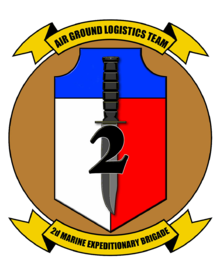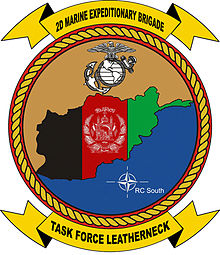Combat service support is a topic that is, broadly speaking, a subset of military logistics. However, combat service support is often more limited in depth, as the related groups primarily address factors supporting readiness for combat operations. The United States Department of Defense organizes various agencies providing services such as medical assistance, for example, akin to other nations' militaries.

The II Marine Expeditionary Force is a Marine Air-Ground Task Force consisting of ground, air and logistics forces capable of projecting offensive combat power ashore while sustaining itself in combat without external assistance for a period of 60 days. The II Marine Expeditionary Force is commanded by a lieutenant general, who serves under U.S. Marine Corps Forces Command, providing Marine fighting formations and units to European Command, Central Command and Southern Command. The current Commanding General is Lieutenant General David A. Ottignon. The Deputy Commanding General is Brigadier General Andrew T. Priddy.
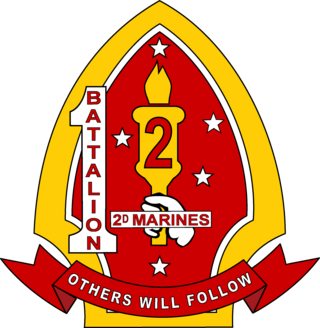
1st Battalion, 2nd Marines (1/2) is an infantry battalion in the United States Marine Corps based out of Marine Corps Base Camp Lejeune, North Carolina, consisting of approximately 900 Marines and sailors. The battalion, callsign "Typhoon'" falls under the command of the 2nd Marine Regiment and the 2nd Marine Division.

The 2nd Marine Regiment is an infantry regiment of the United States Marine Corps. They are based at Marine Corps Base Camp Lejeune, North Carolina and fall under the command of the 2nd Marine Division and the II Marine Expeditionary Force.

1st Battalion, 5th Marines (1/5) is an infantry battalion in the United States Marine Corps based out of Marine Corps Base Camp Pendleton, California consisting of approximately 800 Marines and sailors. Nicknamed Geronimo, it falls under the command of the 5th Marine Regiment and the 1st Marine Division. The battalion was formed in 1914 and has served in every major conflict that the United States has been involved in since then.
Marine Air-Ground Task Force is a term used by the United States Marine Corps to describe the principal organization for all missions across the range of military operations. MAGTFs are a balanced air-ground, combined arms task organization of Marine Corps forces under a single commander that is structured to accomplish a specific mission. The MAGTF was formalized by the publishing of Marine Corps Order 3120.3 in December 1963 "The Marine Corps in the National Defense, MCDP 1-0". It stated:

2nd Battalion, 6th Marines (2/6) is an infantry battalion in the United States Marine Corps based out of Camp Lejeune, North Carolina. Also known as "The Ready Battalion" or "2/6 Spartans", it consists of approximately 800 Marines and Sailors and falls under the command of the 6th Marine Regiment and the 2nd Marine Division.

2nd Battalion of the 11th Marines ("Patriot") is an artillery battalion comprising three firing batteries and a Headquarters Battery. The battalion is stationed at Marine Corps Base Camp Pendleton, California. Its primary weapon system is the M777 lightweight howitzer. The battalion was the first in the Marine Corps to fully transition from the M198 Howitzer. They fall under the command of the 11th Marine Regiment and the 1st Marine Division.
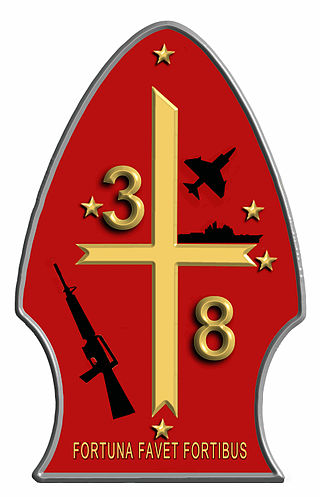
3rd Battalion 8th Marines (3/8) was an infantry battalion in the United States Marine Corps based out of Marine Corps Base Camp Lejeune, North Carolina, was consisted of approximately 1,100 Marines and Sailors. The battalion fell under the command of the 8th Marine Regiment and the 2nd Marine Division.

The 1st Battalion, 6th Marines (1/6) is an infantry battalion in the United States Marine Corps based in Camp Lejeune, North Carolina. It consists of approximately 1,100 marines and sailors. They fall under the command of the 6th Marine Regiment, the 2nd Marine Division of the II Marine Expeditionary Force.

Marine Wing Support Squadron 274 (MWSS-274) is an aviation ground support unit of the United States Marine Corps. They are based out of Marine Corps Air Station Cherry Point, North Carolina. The squadron falls under the command of Marine Wing Support Group 27 and the 2nd Marine Aircraft Wing.

Task Force Tarawa (TFT) was the name given to the 2nd Marine Expeditionary Brigade during the 2003 invasion of Iraq. It was a Marine Air-Ground Task Force commanded by Brigadier General Richard F. Natonski that was attached to the I Marine Expeditionary Force during the course of the invasion and was most notable for its participation in the heavy fighting in the city of an-Nāṣiriyyah. During its time supporting Operation Iraqi Freedom, the task force suffered 23 Marines killed in action.

The United States Marine Corps is organized within the Department of the Navy, which is led by the Secretary of the Navy (SECNAV). The most senior Marine commissioned officer is the Commandant of the Marine Corps, responsible for organizing, recruiting, training, and equipping the Marine Corps so that it is ready for operation under the command of the unified combatant commanders. The Marine Corps is organized into four principal subdivisions: Headquarters Marine Corps, the Operating Forces, the Supporting Establishment, and the Marine Forces Reserve.
A Marine expeditionary brigade (MEB) is a formation of the United States Marine Corps, a Marine air-ground task force of approximately 14,500 Marines and sailors constructed around a reinforced infantry regiment, a composite Marine aircraft group, a combat logistics regiment and a MEB command group. The MEB, commanded by a general officer (usually a brigadier general), is task-organized to meet the requirements of a specific situation. It can function as part of a joint task force, as the lead echelon of the Marine expeditionary force (MEF), or alone. It varies in size and composition, and is larger than a Marine expeditionary unit (MEU) but smaller than a MEF. The MEB is capable of conducting missions across the full range of military operations.

Combat Logistics Battalion 2 (CLB-2) is a logistics unit of the United States Marine Corps (USMC), which provides direct combat service support to Regimental Combat Team 2 (RCT-2). CLB-2 was formed after its second deployment to Iraq in 2005 as a part of the reorganization of the 2nd Force Service Support Group. The battalion falls under Combat Logistics Regiment 2 and the 2nd Marine Logistics Group and is headquartered at Marine Corps Base Camp Lejeune, North Carolina in the USA.

1st Marine Expeditionary Brigade is a unit in the I Marine Expeditionary Force and is the "middleweight" global crisis response force.
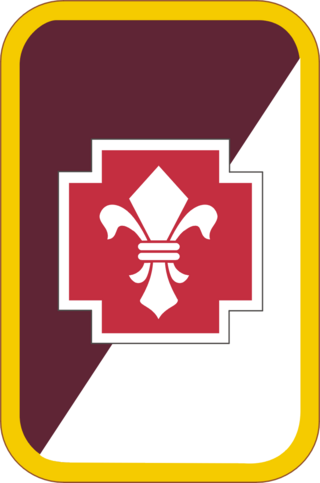
The 62nd Medical Brigade, formerly the 62nd Medical Group of the United States Army is a unit of the Army Medical Department and I Corps and Fort Lewis. It is based entirely at Joint Base Lewis-McChord, Washington. Currently, the brigade is commanded by Colonel Robert S. Heath, the first Physican Assistant in history to command a US Army medical brigade, and Command Sergeant Major Jesus Gonzalez.

Combat Logistics Battalion 6 (CLB-6) is a logistics battalion of the United States Marine Corps. Nicknamed "Red Cloud," the unit is based at Marine Corps Base Camp Lejeune, North Carolina and fall under the command of Combat Logistics Regiment 2 and the 2nd Marine Logistics Group..
In 2009, the United States and NATO International Security Assistance Force (ISAF) coalition, along with Afghan National Army forces, continued military operations against the Taliban in Afghanistan. 2009 marks the eighth year of the War in Afghanistan, which began late in 2001. And 75th ranger regiment is also in Afghanistan as of 2018

Task Force Leatherneck or MEB-Afghanistan was a Marine Air-Ground Task Force that operated in Helmand Province, Afghanistan. The name was originally given to the 2nd Marine Expeditionary Brigade during its 2009-10 operations for Operation Enduring Freedom as part of Regional Command South. It is also the name used by the 1st Marine Division and 2nd Marine Division during their deployments to Afghanistan. Task Force Leatherneck was commanded by Brigadier General Lawrence D. Nicholson with the command element at Camp Leatherneck. The task force took over the battlespace from Special Purpose MAGTF-Afghanistan on May 29, 2009. In July 2009, Task Force Leatherneck participated in Operation Strike of the Sword, the largest Marine Corps operation since the Battle of Fallujah, and then in February 2010 an even larger battle, the largest of the Afghan Campaign, Operation Moshtarak.
